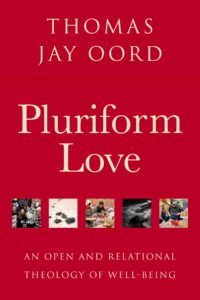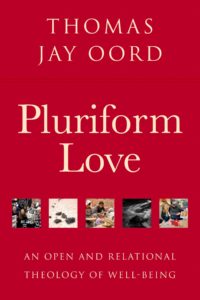The Story Behind Pluriform Love
I’ve written a book that ties together many of my primary thoughts about God and love. It’s called Pluriform Love: An Open and Relational Theology of Well-Being.
The preface of Pluriform Love gives the background story to its writing. And it provides a taste of some of the book’s primary ideas. I thought I’d share this preface…
PREFACE
I’ve been writing this book since birth.
Books that explore love should probably start with a mother’s love… experienced in the womb, through infancy, in childhood, and thereafter. I’m grateful my mother loved me in a plurality of ways. I’m also thankful for the love shown by my fathers, wife, children, siblings, extended family, friends, and so on. But I dedicate this book to the one I call “momma.”
I experienced love growing up in Othello, Washington, and I’ve witnessed love in many communities since. Pastors, mentors, teachers, and elders have modeled love. The global heroes of love — people like Martin Luther King, Jr., Gandhi, Mother Teresa, and Mr. Rogers — influenced me too, albeit indirectly. It’s hard to measure the influence of loving exemplars and communities. We learn through experience.
The rock-n-roll of my youth and today proffers lyrics of love. What songwriters mean by “love” varies, as much as it varies in everyday conversation, literature, philosophy, and even scripture. Shakespeare is right: “Love is a many splendored thing.” But the lyrics and poetry of love move me immensely.
A TESTIMONY
What the Bible says about love captured my attention as a young man, and scripture guides my reflection today. I cannot account fully for the Bible’s influence on how I think, both my direct interpretations of the text and the indirect ways it shaped those who loved me. But what scripture says about love is not as straightforward as many think. Biblical writers use love words in many ways, and we have good reason to be confused. I explore these ways in this book.
My thoughts here have taken a long time to gestate and have gone through many stages. While an undergraduate, I began to imagine love as theology’s guiding principle. As an avid evangelist, I preached the gospel as I understood it. After encountering sophisticated arguments against faith, I admitted my reasons for believing were weak. I became an atheist/agnostic for a time.
Love was crucial to my return to faith. The existence and activity of a loving God made sense of my intuition that I ought to love, others ought to love, and love was the purpose of existence. The ultimacy of love, I believe, provides plausible answers to my biggest questions. Love matters most.
GRADUATE SCHOOL
While a student at Nazarene Theological Seminary, I became convinced love could function as the locus for theology. I began to understand John Wesley’s ideas of holiness and sanctification in light of love. A book I co-wrote with Michael Lodahl, Relational Holiness: Responding to the Call of Love, expressed this conviction. I learned from Professor Rob Staples about Wesley’s focus on love, and Mildred Bangs Wynkoop’s classic book on Wesley, A Theology of Love, underscored this point.
My first course at Claremont Graduate University was on the religious significance of Alfred North Whitehead. The promise of process thought had lured me to Claremont. David Ray Griffin taught that course, and he would become my doctoral advisor. My course paper explored love in Whitehead’s thought – especially persuasive love – and sparked many original ideas.
My doctoral thesis was the first written articulation of this book. I addressed major theologies of love and, to a greater or lesser degree, found each wanting. I argued that putting love first could transform both the Evangelical theology of my upbringing and the process theology I had discovered in the academy. Years later, I rewrote and published the dissertation as The Nature of Love: A Theology (Chalice Press, 2010).
AHA LOVE
As my thinking about love has continued to deepen and expand, I’ve had some “aha” moments, developed new theories, and strengthened earlier convictions. This deepening and expansion prompt me to write Pluriform Love.
Of the 25+ books I’ve written or edited since graduate school, most have “love” in their title or subtitle. With each publication, my wife teases me, “Another love book? Haven’t you said all you can say?”
I shrug and reply, “Apparently not.”
To me, pondering love is like pondering God: my interest never tires. Words never capture love or God fully, but I hope to make progress. I want “to grasp how wide and long and high and deep is the love of Christ, and to know this love that surpasses knowledge” (Eph. 3:18b-19a). A winsome vision of a loving God is central and motivates me to love God, others, myself, and all creation.
PLURIFORM LOVE
To say love is “pluriform,” as this book’s title does, is to say love has multiple dimensions and expressions. Love cannot be understood well nor experienced fully if confined to only one or a few forms. A holistic account of love includes, but goes beyond, the typical categories of sacrifice, sex, desire, friendship, generosity, compassion, and more. Pluriform love points to the diversity of this term.
Not only do creatures express pluriform love, but God does too. Divine love is not just sacrificial. Nor is love simply desire for what’s valuable; it’s not just communal relationship, and it’s not primarily aimed at God’s own glory. To put it positively, divine love is compassionate, involves forgiveness, repays evil with good, delights in beauty, rejoices in the good, and enjoys a good joke. God’s love is pluriform.
God’s love is not altogether different from ours, as some theologians have suggested. It’s not an exception to the fundamental principles of love that apply to all. In fact, the basic meaning of love – although having multifarious expressions – applies to both creatures and the Creator. While a good definition of love should apply uniformly to God and others, the expressions of love are pluriform.
Conventional theologies cannot account well for love. Ours or God’s. Some theologians embrace agape, for instance, but reject eros and philia. In those theologies, God gives but can’t respond to, delight in, or befriend us. Others think of love as desire rather than acting to promote well-being. In some theologies, God only loves Godself.
SCIENCE, PHILOSOPHY, AND SCRIPTURE
In my book, Defining Love, I addressed in detail how we best define love. In it and The Science of Love, I explore the contributions science and philosophy make to understanding love.
Theology takes center stage in the present book. I build from Christian scripture because the Bible provides crucial resources for a Christian theology of love. As I see it, love is primary in scripture.
But good theology requires more than scripture. This book also appeals to reason, experience, and aspects of the Christian tradition. Along the way, I will criticize theologians and biblical scholars who fail to follow the logic of love. I also criticize philosophical assumptions and biblical interpretations that undermine love’s supremacy.
LOVE AND BIG QUESTIONS
When understood well, love illuminates. It answers our biggest questions about God and life. Perhaps the biggest questions for theists and atheists alike revolve around evil. If a loving and powerful God exists, why doesn’t this deity prevent unnecessary suffering, pointless pain, and genuine evils? I’ve answered that question in previous books, including The Uncontrolling Love of God and God Can’t. In this book, I point to what I call “essential kenosis” as crucial to solving the problem of evil.
If the Apostle John is correct that God is love, we need to ask about God’s nature. Can God choose not to love? I’ll answer this by claiming God is essentially loving. The essence-experience binate means Godunchangingly loves but changingly experiences and expresses love moment by moment.
If God always loves creatures, we might wonder if there ever was a time God did not relate to creation. I argue that God’s steadfast love literally endures forever, and I call this “essential hesed.” In covenant with them, God everlastingly relates with and loves creatures and creation.
This book argues that for life to flourish, we need the light of love. We need it to blaze in all directions, not just one or a few. We should celebrate the diversity of love both God and creatures can express.
Creatures can imitate the Creator whose love is pluriform.



Comments